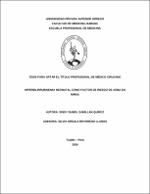Hiperbilirrubinemia neonatal como factor de riesgo de asma en niños

View/
Download
(application/pdf: 788.0Kb)
(application/pdf: 788.0Kb)
Date
2021Author(s)
Samillan Quiroz, Sindy Isabel
Metadata
Show full item recordAbstract
Determinar mediante la revision de la evidencia si la hiperbilirrubinemia neonatal
(HN) es factor de riesgo de asma en niños. Material y Métodos: Se llevó a cabo un artículo
de revisión narrativa con la finalidad de poder desarrollar el objetivo planteado. Realizamos
una búsqueda estructurada de la literatura científica en inglés, persa y español en PubMed,
Science Direct y EBSCO Host, la cual fue complementada con la búsqueda manual de
investigaciones. Luego de la exclusión de editoriales, cartas al editor, ensayos y artículos
de opinión, fueron seleccionados 123 artículos. Los términos MESH utilizados fueron,
ASMA INFANTIL, HIPERBILIRRUBINEMIA NEONATAL y RIESGO. Resultados: Se
encontró un panorama epidemiológico mundial variable y una etiología multifactorial para
HN y asma infantil (AI), siendo la HN severa y la crisis asmática los estados relacionados a
mayor morbimortalidad. La mayor parte de la evidencia científica encontró asociación entre
HN y AI, siendo establecida la condición de riesgo en pocos estudios. Por otro lado, la
participación en común del gen de la glutatión – S – transferasa (GST) para ambos
escenarios patológicos podría actuar como un confusor de los resultados hallados.
Conclusión: La hiperbilirrubinemia neonatal (HN) como factor de riesgo de asma en niños
no es absolutamente concluyente, dejando entrever que aún se requiere mayores
investigaciones a fin de poder determinar causalidad. To determine by reviewing the evidence if neonatal hyperbilirubinemia (NH) is a
risk factor for asthma in children. Material and Methods: A narrative review article was
carried out in order to develop the stated objective. We conducted a structured search of the
scientific literature in English, Farsi, and Spanish in PubMed, Science Direct, and EBSCO
Host, which was complemented by a manual research search. After excluding editorials,
letters to the editor, essays and opinion articles, 123 articles were selected. The MESH
terms used were CHILDHOOD ASTHMA, NEONATAL HYPERBILIRUBINEMIA and RISK.
Results: A variable worldwide epidemiological panorama and a multifactorial etiology were
found for NH and childhood asthma (AI), with severe NH and asthma crisis being the states
related to higher morbidity and mortality. Most of the scientific evidence found an association
between HN and AI, the risk condition being established in few studies. On the other hand,
the common participation of the glutathione-S-transferase (GST) gene for bothpathological
scenarios could act as a confounder of the results found. Conclusion: Neonatal
hyperbilirubinemia (NH) as a risk factor for asthma in children is not absolutely conclusive,
suggesting that further research is still required in order to determine causality
Collections
- Medicina Humana [2969]

